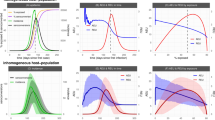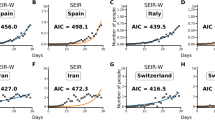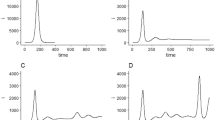Abstract
In many infectious diseases, an unknown fraction of infections produce symptoms mild enough to go unrecorded, a fact that can seriously compromise the interpretation of epidemiological records. This is true for cholera, a pandemic bacterial disease, where estimates of the ratio of asymptomatic to symptomatic infections have ranged from 3 to 100 (refs 1–5). In the absence of direct evidence, understanding of fundamental aspects of cholera transmission, immunology and control has been based on assumptions about this ratio and about the immunological consequences of inapparent infections. Here we show that a model incorporating high asymptomatic ratio and rapidly waning immunity, with infection both from human and environmental sources, explains 50 yr of mortality data from 26 districts of Bengal, the pathogen’s endemic home. We find that the asymptomatic ratio in cholera is far higher than had been previously supposed and that the immunity derived from mild infections wanes much more rapidly than earlier analyses have indicated. We find, too, that the environmental reservoir5,6 (free-living pathogen) is directly responsible for relatively few infections but that it may be critical to the disease’s endemicity. Our results demonstrate that inapparent infections can hold the key to interpreting the patterns of disease outbreaks. New statistical methods7, which allow rigorous maximum likelihood inference based on dynamical models incorporating multiple sources and outcomes of infection, seasonality, process noise, hidden variables and measurement error, make it possible to test more precise hypotheses and obtain unexpected results. Our experience suggests that the confrontation of time-series data with mechanistic models is likely to revise our understanding of the ecology of many infectious diseases.
This is a preview of subscription content, access via your institution
Access options
Subscribe to this journal
Receive 51 print issues and online access
$199.00 per year
only $3.90 per issue
Buy this article
- Purchase on Springer Link
- Instant access to full article PDF
Prices may be subject to local taxes which are calculated during checkout



Similar content being viewed by others
References
Kaper, J. B., Morris, J. G. & Levine, M. M. Cholera. Clin. Microbiol. Rev. 8, 48–86 (1995)
Feachem, R. G. Environmental aspects of cholera epidemiology. III. Transmission and control. Trop. Dis. Bull. 79, 1–47 (1982)
Van De Linde, P. A. M. & Forbes, G. I. Observations on the spread of cholera in Hong Kong, 1961–63. Bull. World Health Organ. 32, 515–530 (1965)
McCormack, W. M., Islam, M. S., Fahimuddin, M. & Mosley, W. H. A community study of inapparent cholera infections. Am. J. Epidemiol. 89, 658–664 (1969)
Glass, R. I. & Black, R. E. in Cholera (eds Barua, D. & Greenough, W.B. III) 129–154 (Plenum Medical Book Co., New York, 1992)
Islam, M. S., Drasar, B. S. & Sack, R. B. The aquatic environment as a reservoir of Vibrio cholerae: a review. J. Diarrhoeal Dis. Res. 11, 197–206 (1993)
Ionides, E. L., Bretó, C. & King, A. A. Inference for nonlinear dynamical systems. Proc. Natl Acad. Sci. USA 103, 18438–18443 (2006)
Sack, D. A., Sack, R. B., Nair, G. B. & Siddique, A. K. Cholera. Lancet 363, 223–233 (2004)
Sanitary Commissioner for Bengal Reports and Bengal Public Health Reports. (Bengal Secretariat Press, Calcutta and Bengal Government Press, Alipore, 1891–, 1942)
Glass, R. I., Lee, J. V., Huq, M. I., Hossain, K. M. & Khan, M. R. Phage types of Vibrio cholerae O1 biotype El Tor isolated from patients and family contacts in Bangladesh: epidemiologic implications. J. Infect. Dis. 148, 998–1004 (1983)
Sack, R. B. et al. A 4-year study of the epidemiology of Vibrio cholerae in four rural areas of Bangladesh. J. Infect. Dis. 187, 96–101 (2003)
Huq, A. et al. Critical factors influencing the occurrence of Vibrio cholerae in the environment of Bangladesh. Appl. Environ. Microbiol. 71, 4645–4654 (2005)
Koelle, K. & Pascual, M. Disentangling extrinsic from intrinsic factors in disease dynamics: a nonlinear time series approach with an application to cholera. Am. Nat. 163, 901–913 (2004)
Levine, M. M. et al. in Acute Enteric Infections in Children: New Prospects for Treatment and Prevention (eds Holme, T., Holmgren, J., Merson, M. H. & Mollby, R.) 443–459 (Elsevier/North-Holland Biomedical Press, Amsterdam, 1981)
Cash, R. A. et al. Response of man to infection with Vibrio cholerae. II. Protection from illness afforded by previous disease and vaccine. J. Infect. Dis. 130, 325–333 (1974)
Glass, R. I. et al. Endemic cholera in rural Bangladesh, 1966–1980. Am. J. Epidemiol. 116, 959–970 (1982)
Koelle, K., Rodo, X., Pascual, M., Yunus, M. & Mostafa, G. Refractory periods and climate forcing in cholera dynamics. Nature 436, 696–700 (2005)
World Health Organization. Wkly Epidemiol. Rec. 〈http://www.who.int/wer〉 (1950–, 1965)
Cash, R. A. et al. Response of man to infection with Vibrio cholerae. I. Clinical, serologic, and bacteriologic responses to a known inoculum. J. Infect. Dis. 129, 45–52 (1974)
Hartley, D. M., Morris, J. G. & Smith, D. L. Hyperinfectivity: a critical element in the ability of V. cholerae to cause epidemics? PLoS Med. 3, 63–69 (2006)
Siddique, A. K. et al. Survival of classic cholera in Bangladesh. Lancet 337, 1125–1127 (1991)
Bouma, M. J. & Pascual, M. Seasonal and interannual cycles of endemic cholera in Bengal 1891–1940 in relation to climate and geography. Hydrobiologia 460, 147–156 (2001)
Faruque, S. M. et al. Self-limiting nature of seasonal cholera epidemics: Role of host-mediated amplification of phage. Proc. Natl Acad. Sci. USA 102, 6119–6124 (2005)
Faruque, S. M. et al. Seasonal epidemics of cholera inversely correlate with the prevalence of environmental cholera phages. Proc. Natl Acad. Sci. USA 102, 1702–1707 (2005)
Jensen, M. A., Faruque, S. M., Mekalanos, J. J. & Levin, B. R. Modeling the role of bacteriophage in the control of cholera outbreaks. Proc. Natl Acad. Sci. USA 103, 4652–4657 (2006)
R Development Core Team. R: a language and environment for statistical computing (R Foundation for Statistical Computing, Vienna, Austria, 2007)
Rodo, X., Pascual, M., Fuchs, G. & Faruque, A. S. G. ENSO and cholera: a nonstationary link related to climate change? Proc. Natl Acad. Sci. USA 99, 12901–12906 (2002)
Kloeden, P. E. & Platen, E. Numerical Solution of Stochastic Differential Equations 3rd edn (Springer, New York, 1999)
Casella, G. & Berger, R. L. Statistical Inference (Wadsworth, Pacific Grove, 1990)
Rice, J. A. Mathematical Statistics and Data Analysis (Wadsworth, Belmont, California, 1988)
Barndorff-Nielsen, O. E. & Cox, D. R. Inference and Asymptotics (Chapman and Hall, London, 1994)
Hilborn, R. & Mangel, M. The Ecological Detective (Princeton University Press, Princeton, New Jersey, 1997)
McCullagh, P. & Nelder, J. A. Generalized Linear Models 2nd edn (Chapman and Hall, London, 1989)
Self, S. G. & Liang, K.-Y. Asymptotic properties of maximum likelihood estimators and likelihood ratio tests under nonstandard conditions. J. Am. Stat. Assoc. 82, 605–610 (1987)
Anisimova, M., Bielawski, J. P. & Yang, Z. Accuracy and power of the likelihood ratio test in detecting adaptive molecular evolution. Mol. Biol. Evol. 18, 1585–1592 (2001)
Akaike, H. A new look at the statistical model identification. IEEE Trans. Automat. Contr. 19, 716–723 (1974)
Burnham, K. P. & Anderson, D. R. Model Selection and Inference: A Practical Information–Theoretic Approach 2nd edn (Springer, New York, 2002)
Acknowledgements
We acknowledge discussions with K. Koelle, C. Bretó and A.P. Dobson. This work was funded by the joint National Science Foundation–National Institutes of Health Ecology of Infectious Diseases Program (NSF grants nos 0545276 and 0430120) and the National Oceanic and Atmospheric Administration (Oceans and Health, grant no. NA040AR460019).
Author Contributions A.A.K. formulated and implemented the models, implemented the fitting algorithm, performed the analyses, and drafted and revised the text. E.L.I. provided input on the models and statistical analyses, and drafted much of the Supplementary Information. M.P. provided input on the models and commented on the text. M.J.B. extracted and assembled the data and provided input on the models and on the historical and clinical aspects of cholera.
Author information
Authors and Affiliations
Corresponding author
Supplementary information
Supplementary information
The file contains Supplementary Equations, Supplementary Methods, Supplementary Discussion, Supplementary Figures S1-S3 with Legends, Supplementary Tables S1-S6 and additional references. (PDF 301 kb)
Rights and permissions
About this article
Cite this article
King, A., Ionides, E., Pascual, M. et al. Inapparent infections and cholera dynamics. Nature 454, 877–880 (2008). https://doi.org/10.1038/nature07084
Received:
Accepted:
Issue Date:
DOI: https://doi.org/10.1038/nature07084
This article is cited by
-
Clinical surveillance systems obscure the true cholera infection burden in an endemic region
Nature Medicine (2024)
-
Environmental transmission of Pseudogymnoascus destructans to hibernating little brown bats
Scientific Reports (2023)
-
Model-Based Estimation of Expected Time to Cholera Extinction in Lusaka, Zambia
Bulletin of Mathematical Biology (2023)
-
Modeling the health impact of water and sanitation service deficits on waterborne disease transmission
Advances in Difference Equations (2021)
-
Tracing contacts to evaluate the transmission of COVID-19 from highly exposed individuals in public transportation
Scientific Reports (2021)
Comments
By submitting a comment you agree to abide by our Terms and Community Guidelines. If you find something abusive or that does not comply with our terms or guidelines please flag it as inappropriate.



